“If you’re struggling to hit your micronutrient counts each day through whole foods alone, you can fill those gaps with supplements featuring some of the most beneficial vitamins and minerals for overall health and wellness,” says Dr. Raj Dasgupta, MD. Sharing similarities to popular multivitamins, the best greens powders have gained a ton of traction as of late given their ability to provide athletes with foundational vitamins and minerals along with other additives for gut health, cognitive function, immune support, cardiovascular health, and more. (1)(2)(3) When it comes to the current landscape, there may be no product more well-known than AG1 Next Gen.
In our opinion, AG1 Next Gen backs up its successful marketing campaign with a high-quality formulation that’s rich with whole-food sources, albeit with some clarity issues on detailed serving sizes. While the price may be a tough hurdle to overcome for more budget-conscious individuals, we feel this third-party approved greens supplement can still be an excellent addition to your daily regimen. In this AG1 Next Gen review, we’ll dive deep into the full formulation of this recognizable dietary supplement and provide insight based on our supplement testing methodology and previous experiences with nearly 40 different greens powders.
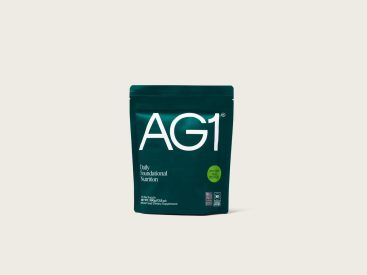
This nutritious greens powder is NSF certified for sport and includes over 75 absorbable ingredients and is free of gluten, sugar, dairy, eggs, and peanuts. It is compatible with vegan, keto, and paleo diets.
Medical disclaimer: The content on BarBend is meant to be informative in nature, but it should not be taken as medical advice. The opinions and articles on this site are not intended for use as diagnosis, prevention, and/or treatment of health problems. It’s always a good idea to talk to your doctor before beginning a new fitness, nutritional, and/or supplement routine. Individual needs for vitamins and minerals will vary.
AG1 Next Gen Video Review
Join BarBend expert reviewer Nick English as he details AG1 Next Gen’s benefits, drawbacks, taste, pricing, ingredients list, and more.
Main Takeaways
- AG1 Next Gen is a highly comprehensive formula consisting of 75 ingredients for a full vitamin and mineral complex and four nutritional blends for total-body support.
- While AG1 Next Gen is NSF Certified for Sport, the amounts of ingredients in its proprietary blends are not disclosed.
- Unlike most greens powders, AG1 Next Gen tastes slightly sweet, using the natural essence of pineapple core and vanilla bean instead of artificial flavors or sweeteners.
AG1 Next Gen Specs
| Price Per Serving | $3.33 (for a one-time purchase) |
| Calories Per Serving | 40 |
| Included Vitamins | Vitamin A, vitamin C, vitamin E, vitamin B1, vitamin B2, niacin, vitamin B6, folate, vitamin B12, biotin, pantothenic acid |
| Included Minerals | Calcium, phosphorus, magnesium, zinc, selenium, copper, manganese, chromium, sodium, potassium |
| Available Flavors | Original, Tropical |
| Whole-Food Sources | Acerola, alfalfa, apple, artichoke, barley grass, bilberry, bioflavonoids, broccoli flower, carrots, cocoa bean polyphenol extract, hawthorn berry, lycium berry, natural pineapple flavor, natural vanilla flavor, papaya, pea protein, pineapple, spinach, spirulina, stevia, wheatgrass |
| Digestive Support | Beta glucan, bromelain, bifidobacterium bifidum, inulin, lactobacillus acidophilus |
| Adaptogens | Ashwagandha, astragalus, beet powder, burdock root, chlorella, citric acid, dandelion root, eleuthero root, ginger, grapeseed extract, green tea extract, kelp, lecithin, licorice, milk thistle, policosanol, reishi mushroom, rhodiola, rose hips, rosemary, shiitake mushroom, slippery elm |
| Sweeteners Used | Stevia leaf powder |
| Third-Party Testing | YES (NSF Certified for Sport) |
If you’ve seen one of the (many) AG1 Next Gen advertisements on social media — or interspersed within your favorite podcast streams — you’re likely aware of the brand’s subscription-based service. If you want to add this to your supplement routine of the best protein powders and creatines, we recommend opting for repeat deliveries given the cost of the product itself. A one-time purchase of a 30-serving container costs $99, or roughly $3.33 per serving. This is well above the average cost of other greens powders, which typically fall between $1.50 and $2.00 per serving. “AG1 justifies the product’s monthly cost based on the cost of the individual products it would ‘replace.’ I think this is a little unrealistic,” says Chelsea Rae Bourgeois, RDN, BarBend expert reviewer. “For example, it leads you to believe that AG1 can replace a multivitamin. While it certainly provides large doses of some vitamins (WAY more than the recommended daily value), it falls entirely short of others.”
Speaking of the makeup, AG1 Next Gen consists of over 75 ingredients, including whole-food sources like spirulina, alfalfa, pineapple, spinach, and wheatgrass, among others. This comprehensive makeup helps AG1 Next Gen achieve a full spectrum of vitamins and minerals, which can be beneficial for a range of different needs including joint health, heart health, cognitive function, immune support, and more. (4)
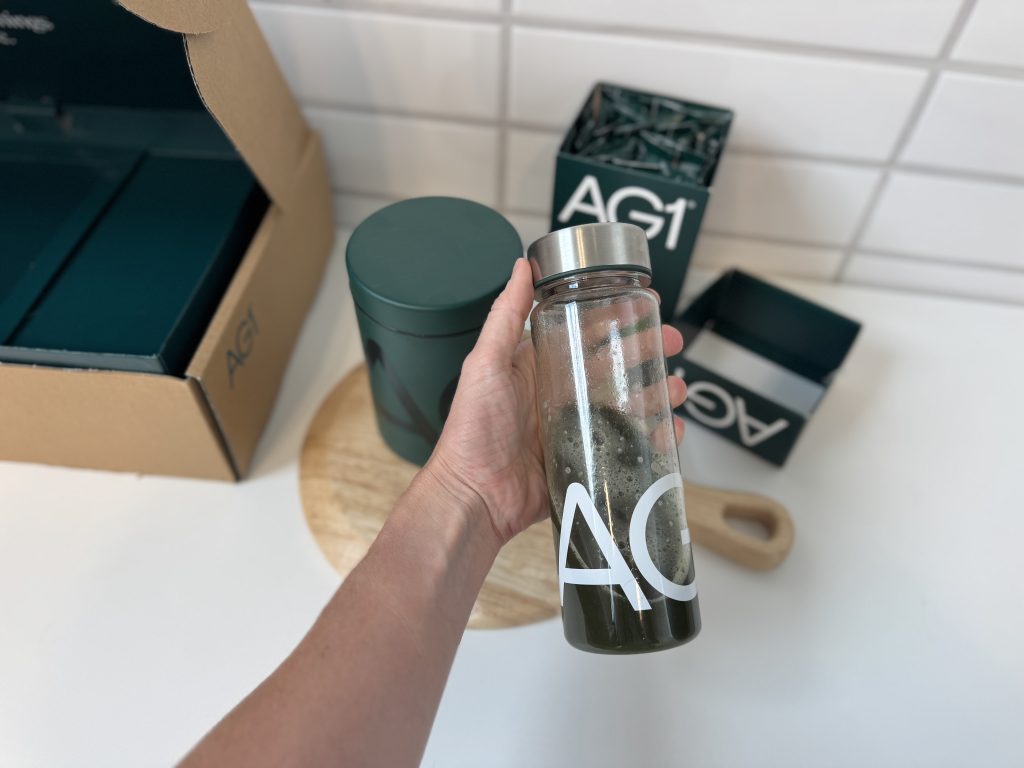
AG1 Next Gen also has five clinically studied proprietary blends targeting different aspects of overall health, such as a 10-billion-CFU probiotics blend of lactobacillus rhamnosus, lactobacillus acidophilus, bifidobacterium lactis, lactobacillus casei, and lactobacillus plantarum. Studies report that probiotics can be helpful for gut health and promote a high-functioning gut microbiome for effects like GI efficiency, cognitive function, and immunity. (5) Having these colony-forming units within the makeup can be a convenient way to improve your gut health, too, since its presence eliminates the need to supplement with other products (like the best probiotic supplements).
“I appreciate that AG1 Next Gen is NSF-Certified for Sport, meaning it has been tested and deemed free from more than 280 banned substances. And while it’s not done through a third party, I appreciate that every batch of AG1 is tested for quality and purity, and the certificates of analysis are available online,” adds Bourgeois.
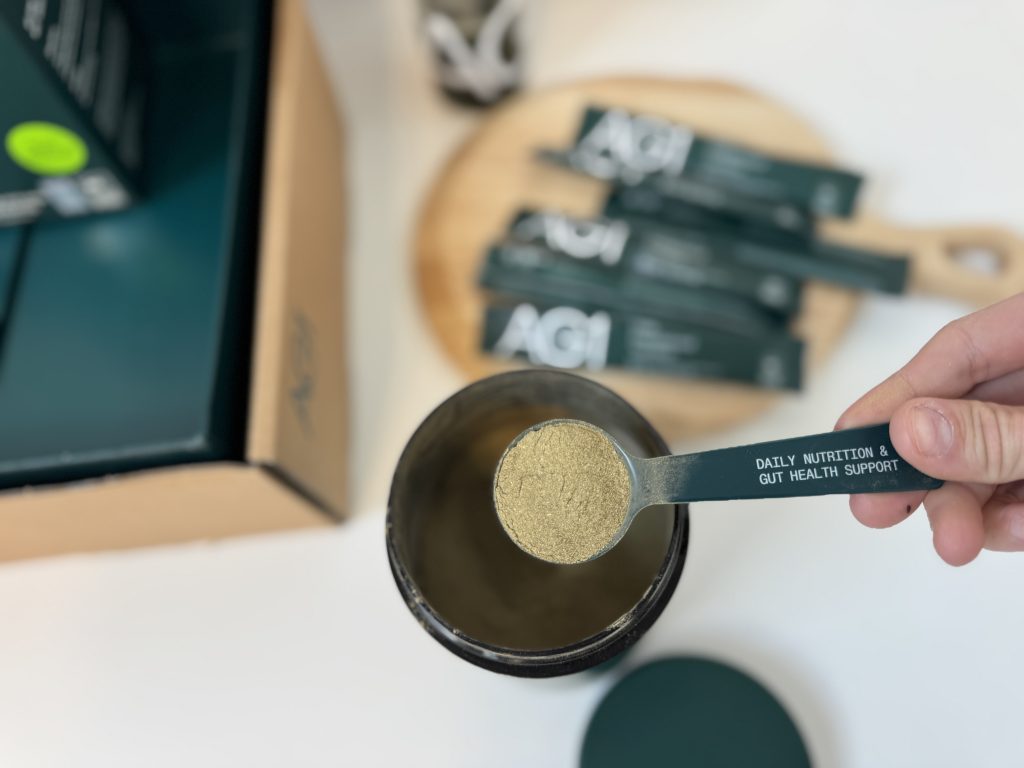
AG1 Next Gen comes in both Original and Tropical flavors. In the original flavor, the included pineapple and stevia leaf powder do create a fruity, enjoyable experience that sheds any unwanted “earthiness” from the profile. The “tropical” flavor boasts hints of papaya and passionfruit to transport your taste buds.
Who Should Use / Who Shouldn’t Use AG1 Next Gen
OK, so this greens supplement may seem like a no-brainer for many, but is AG1 Next Gen a true fit for every need? Like the best multivitamins, pre-workouts, and other supplements, the answer can depend on your personal fitness goals and health needs. Below, we’ve outlined a handful of camps that we feel could benefit from this AG1 Next Gen supplement, along with some who may fare better with a different greens powder or other vitamin-rich product.
Recommended for:
- Athletes wanting a comprehensive supplement targeting energy levels, micronutrient needs, immune system support, and other health benefits in one singular powder.
- Individuals looking for a greens powder with added digestive enzymes to support their gut health. (5)
- Those that prefer a subscription-based supplement model for more convenient repeat orders.
Not Recommended for:
- Budget-conscious individuals in search of a greens powder around the average $1.50 to $2.00 cost per serving (or lower).
- People in search of detailed serving sizes for each ingredient featured in their supplements.
Our Experience Using AG1 Next Gen
The BarBend team is made up of competitive athletes, certified personal trainers, nutrition coaches, and lifelong fitness enthusiasts. In this AG1 Next Gen review, we examined the powder’s formulation and value alongside real-world factors like taste, solubility, and noticeable side effects, similar to the supplement testing methodology we’ve used in trials with 39 other greens powders over the years. We compiled our notes and findings, rating AG1 Next Gen on a scale of 1 (lowest) to 5 (highest). Read below to learn more about how this hyped daily supplement performed under our critique.
Ingredients and Formulation
The supplement facts on AG1 Next Gen cater to multiple nutritional needs. In addition to the vitamins and minerals such as B vitamins, biotin, folate, magnesium, vitamin A, vitamin E vitamin K2, and zinc, the powder also includes proprietary blends catering to digestive support, stress adaptogens, prebiotics, probiotics, antioxidants, superfood sources, and functional mushrooms.
“It’s a mountain of ingredients,” says our product tester, a certified personal trainer. “While it may be overwhelming when reading through the entire nutritional information, I do appreciate the well-rounded makeup. It feels as if my morning greens powder is actually working in favor of my investment into my personal health.”
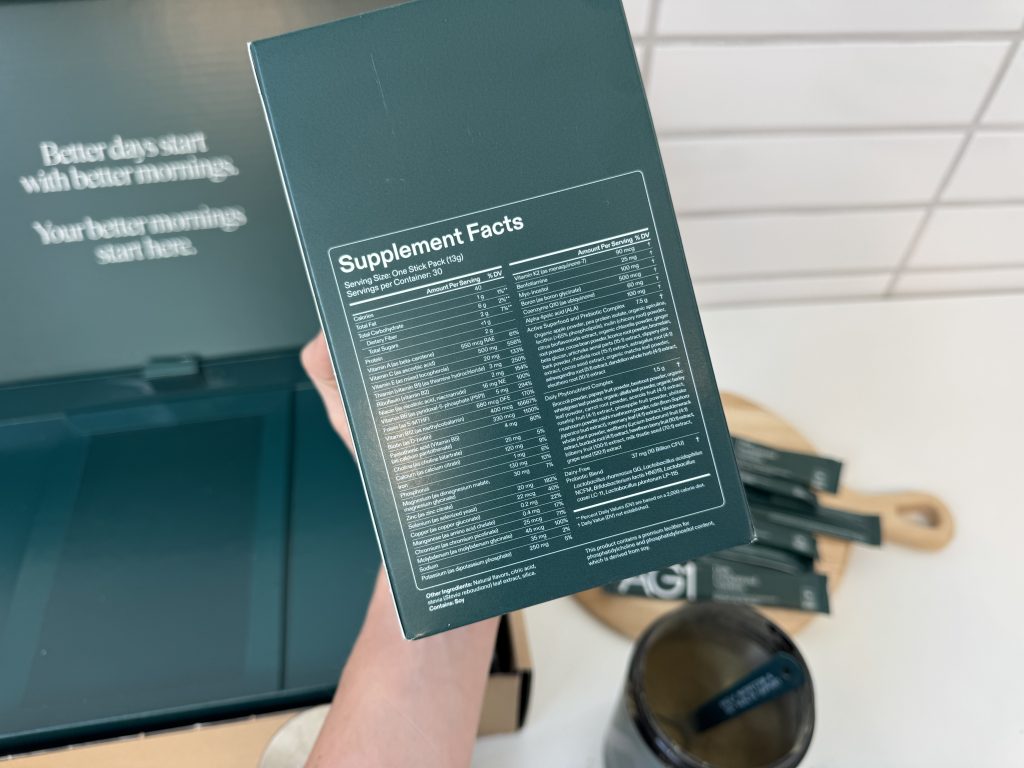
While we praise AG1 Next Gen’s variety of included ingredients, we do wish the brand illustrated the actual dosages of the 75+ included compounds. Many of the featured ingredients are hidden under proprietary blends, earning AG1 Next Gen a 3.5 out of 5 rating from Chelsea Rae Bourgeois, MS, RDN, LD. “While AG1 contains proprietary blends, they list the ingredients in every blend. They just don’t tell you how much of each ingredient is included,” she notes.
We don’t doubt that you’ll be able to fill some nutritional gaps with AG1 Next Gen, but you may just need to keep a closer eye on your daily counts than previously suspected. As a final note on this greens powder’s formulation, we did notice that the dosages varied among certain vitamins and minerals. “You get 556 percent of the recommended daily value of vitamin C, but only 6 percent of the recommended iron, 7 percent of magnesium, etc. If your doctor recommended a daily multi-vitamin, this greens powder probably wouldn’t get the job done. I also expected to see more fiber per serving, considering one of its major purported benefits is improved digestion and gut health,” notes Bourgeois.
While AG1 Next Gen contains 120 milligrams of calcium, there is no listed serving of vitamin D (although the brand does offer a complementary vitamin D3 supplement that can be used in tandem with AG1 Next Gen). This foundational vitamin can be beneficial for musculoskeletal health, brain function, immunity, and more. (6) If you’re trying to level off any vitamin D deficiencies, we recommend opting for some of the best vitamin D supplements over this all-encompassing greens powder.
Taste
Our reviews were mixed on the taste of AG1 Next Gen. One tester, a certified personal trainer, states the included pineapple and vanilla extracts create an enjoyable taste that’s elevated beyond your typical “grassy” or “earthy” notes often associated with greens supplements. “It’s hard to get rid of that ‘healthy’ taste of any greens supplement, but I do feel the stevia, pineapple, and vanilla combine for a great sip,” they note. “In all fairness, I wouldn’t mind continuing with AG1 Next Gen — it’s one of the best-tasting greens I’ve had in my rotation.” However, another tester said “I personally thought it tasted just like greens are supposed to taste like, but not in a good way. It left a really bad aftertaste that took a few minutes to go away.” Between those two diverging tasting notes, we rate the AG1 Next Gen taste a 4 out of 5.
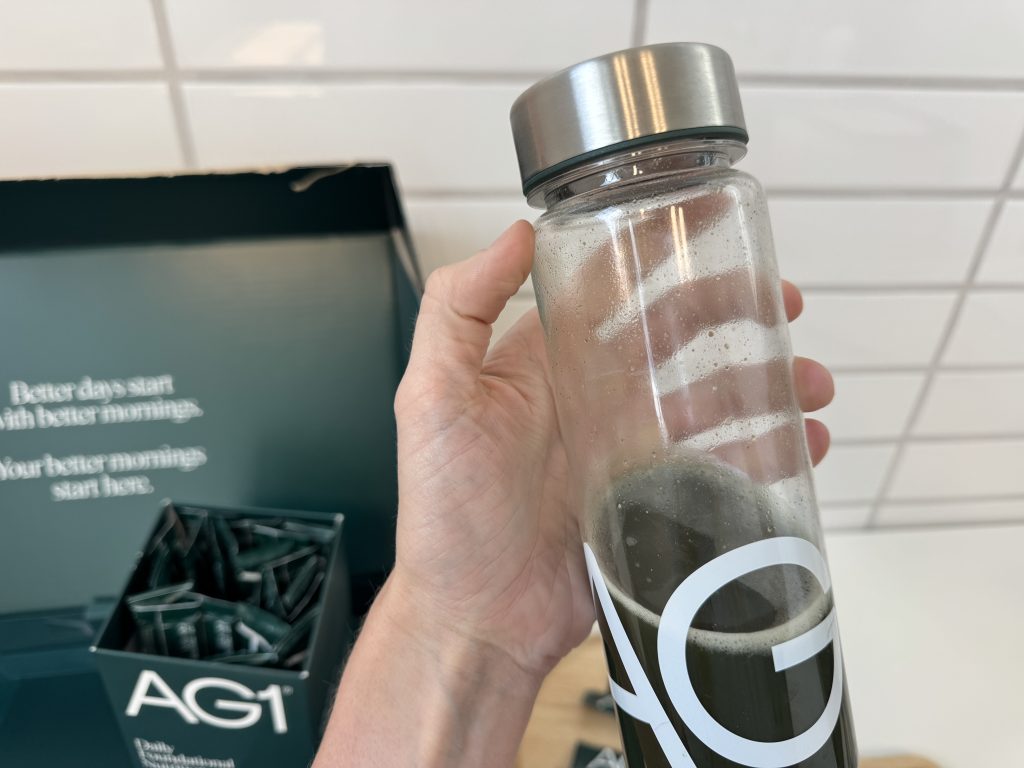
However, we do appreciate that the AG1 Next Gen formula comes in both original and tropical. If you’re on the hunt for a more fruit-centric flavor, you might try the Tropical flavor option. Also, we do want to call out that AG1 Next Gen is sweetened with stevia leaf powder. Studies suggest that stevia consumption can lead to GI distress in some athletes, so be sure to take your personal sensitivities into consideration before subscribing to an order of your own. (7)
Solubility
A supplement that won’t mix easily can be a motivation-draining experience, especially when that supplement is part of your morning routine. Thankfully, our tester, a certified personal trainer, notes no issues regarding solubility with AG1 Next Gen. “All that’s needed is my best shaker bottle and around 8 ounces of cold water. A few shakes and the beverage is ready for sipping,” they add in reference to their 4 out of 5 solubility rating.
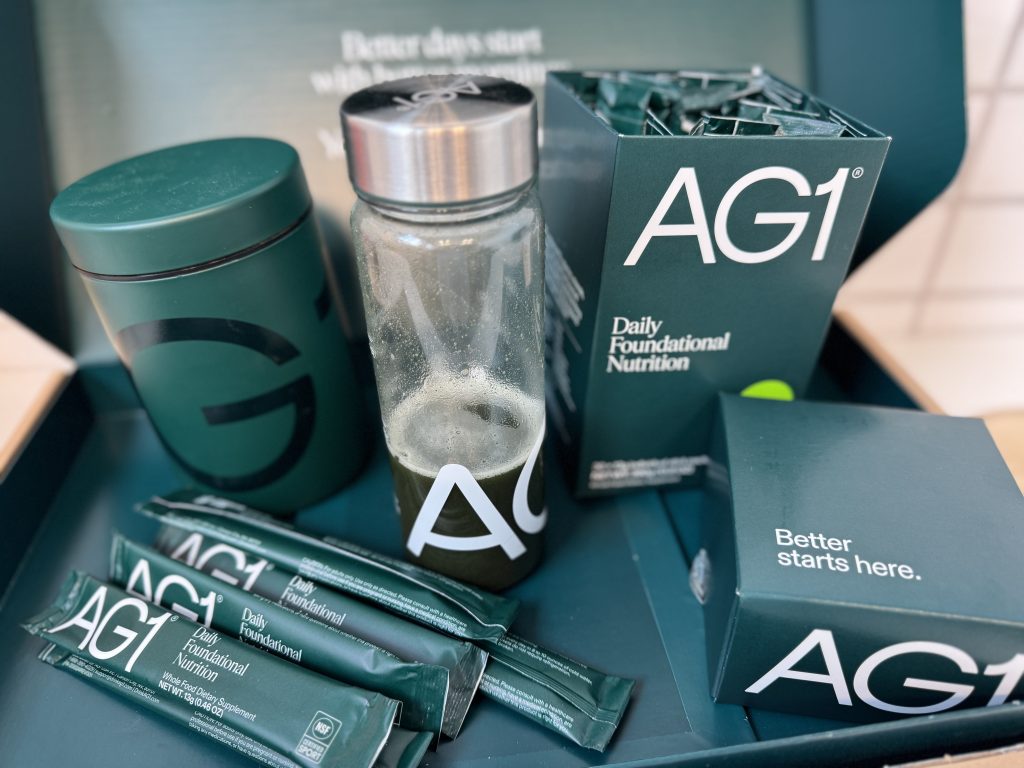
I, too, have experience with AG1 Next Gen and can attest to its simple mixability. I do, however, suggest finishing your serving in a few gulps, since the powder can begin to settle if left undisturbed. Also, as is the case with most greens powders, you can detect some grittiness, but there aren’t any excessive clumps or residue. If you are worried about the mouthfeel, you can experiment with adding AG1 Next Gen to your favorite morning smoothie with other ingredients like tasty fruits and veggies.
Side Effects
During trials, our tester, a certified personal trainer, said there weren’t any noticeable side effects from AG1 Next Gen, positive or negative. “I didn’t experience any bloating or GI distress, so I feel like the formulation agreed with my stomach,” they add. “I haven’t seen any increases in energy or improved focus yet, but I have only been taking the supplement for a few weeks.”
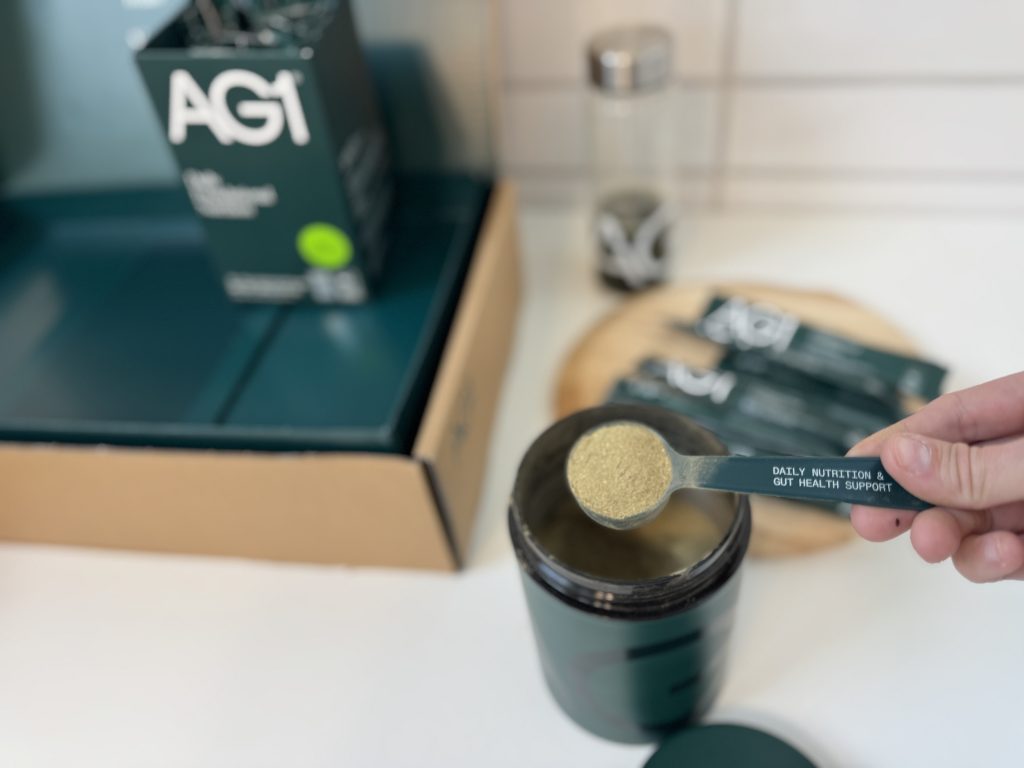
We do rate the side effects at 4 out of 5, though, since side effects can be subjective from one athlete to the next. For example, the included probiotics in AG1 Next Gen may leave some with sensations like bloating or GI sensitivity. (8) As your body adapts to the new microbiota, these symptoms should subside over time. Of course, though, if you are concerned with potential interactions, be sure to speak to your personal healthcare provider prior to adding AG1 Next Gen to your morning routine.
Price Per Serving
Eventually, we had to mention the elephant in the room — AG1 Next Gen is one of the most expensive greens powders at roughly $3.33 per serving for a one-time purchase. The Subscribe and Save option comes in slightly cheaper, at $79 per order and $2.64 per serving, but even these figures don’t drop the price to the average $1.50 to $2.00 costs of other greens supplements. Accordingly, we rate the price per serving at 1 out of 5.
Third Party Testing
“What I will give AG1 Next Gen praise for is the fact that it’s third-party tested,” says Chelsea Rae Bourgeois, MS, RDN, LD. “There are limited studies on greens supplements to date, so I do appreciate the brand offering this product to independent labs for testing.” AG1 Next Gen also earns a 5 out of 5 rating for the category since its NSF Certified for Sport. This accreditation can be excellent for athletes looking to avoid supplements with unknown contaminants.
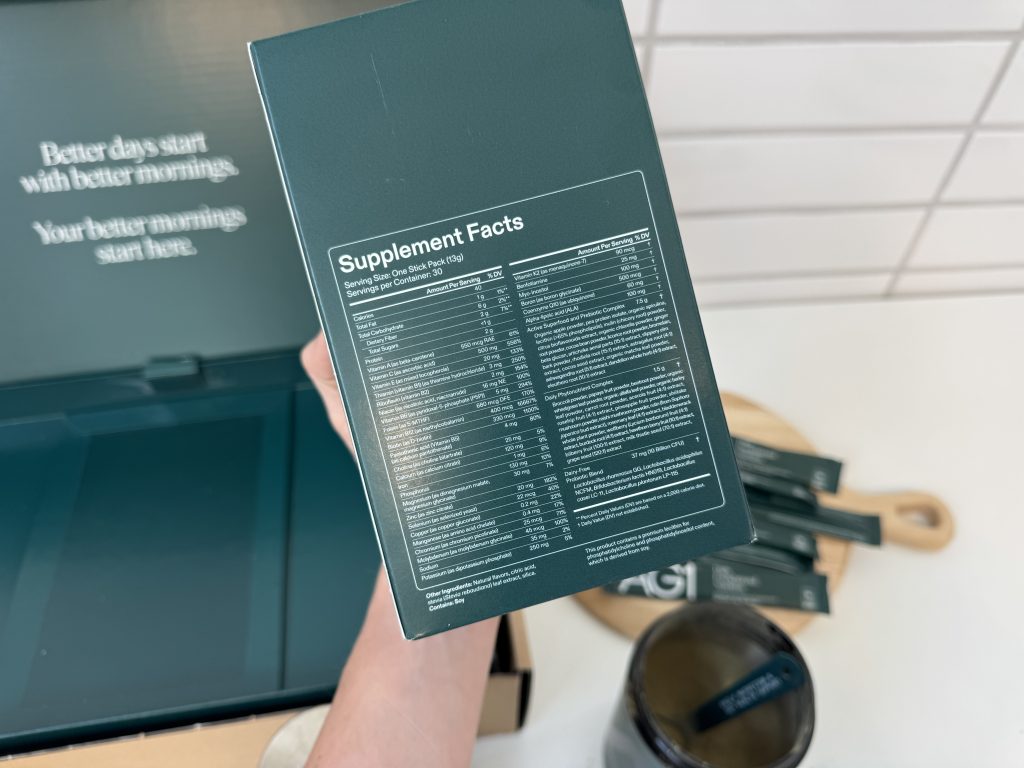
We also appreciate the rigorous clinical studies that AG1 Next Gen is subjected to. AG1 Next Gen is backed by four clinical trials and has been clinically shown to help fill common nutrient gaps and support gut health.
This popular greens powder is also rather inclusive to specific diets. The brand states that AG1 Next Gen is vegetarian- and vegan-friendly, paleo-friendly, keto-friendly, low-carb, and halal. The formulation is also free of GMOs, artificial sweeteners, gluten, dairy, lactose, egg, and peanuts.
What to Consider Before Buying AG1 Next Gen
According to Dr. Raj Dasgupta, MD, “People with inadequate diets, active individuals, pregnant or breastfeeding women, and older adults can potentially benefit from a greens powder or multivitamin supplement as they can be great for filling nutritional gaps and fueling body functions where whole-food intake is less sufficient.” (1)(2)(3) As such, though, there are some considerations worth pondering over when deciding on a supplement of choice. Before signing up for your brand-new AG1 Next Gen subscription, be sure to think through the following:
- Listed Ingredients: Many greens powders use whole-food sources and natural sweeteners to create their beneficial formulations, but some may be underserving in specific nutrients that may impact your experience. Think about your intended fitness goals and what you’re looking to gain from a greens supplement, then compare the formulation to see if it can help bolster your performance and wellness with proper inclusions.
- Proper Dosages: In addition to the quantity of key vitamins and minerals, you’ll also want to ensure that they’re dosed adequately to help you reach recommended daily allowances. Scroll through the ingredients list and compare the daily value percentages of top compounds, contrasting the delivered serving to your current balanced diet to avoid any shortcomings or overindulgence.
- Value: Given their diverse list of ingredients aimed at different benefits, greens powders can be more expensive than other supplements in your repertoire — think the cost of the best whey isolates versus your standard container of whey protein concentrate. On average, though, you can typically find high-quality greens powders between $1.50 and $2.00 per serving. Crunch some numbers, determine your budget, and look for a formulation that matches your desired investment.
- Third-Party Testing: Greens powders, like other supplements, are not regulated by the Food and Drug Administration, so finding a formulation with third-party testing can be a reassuring way to confirm the formulation is labeled accurately and free of contaminants or banned substances. (9) Common third-party testing institutions include Informed Choice, Informed Choice, and NSF, among others.
AG1 Next Gen Vs. Competitors
As you can expect, AG1 Next Gen is not the lone greens powder on the market, despite the elevated hype. Naturally, then, some formulations can be more of a fit for certain athletes. Below, we’ve gathered key specs for two greens supplements we feel match up well to AG1 Next Gen: Bloom Greens and Primal Harvest Primal Greens.
| AG1 Next Gen | Bloom Greens | Primal Harvest Primal Greens | |
| Price Per Serving | $3.33 | Starting at $1.23 | $1.60 |
| Calories Per Serving | 40 | 15 | 35 |
| Included Vitamins | Vitamin A, vitamin C, vitamin E, vitamin B1, vitamin B2, niacin, vitamin B6, folate, vitamin B12, biotin, pantothenic acid | Not listed online | Vitamin C, vitamin E, vitamin B12 |
| Included Minerals | Calcium, phosphorus, magnesium, zinc, selenium, copper, manganese, chromium, sodium, potassium | Iron, sodium | Zinc, copper |
| Available Flavors | Original, Tropical | Apple Cider, Berry, Citrus, Coconut, Mango, Orange Passionfruit, Original, Pineapple, Spiced Cranberry, Strawberry Kiwi, Tropical Variety | Original, Cinnamon |
| Whole-Food Sources | Acerola, alfalfa, apple, artichoke, barley grass, bilberry, bioflavonoids, broccoli flower, carrots, cocoa bean polyphenol extract, hawthorn berry, lycium berry, natural pineapple flavor, natural vanilla flavor, papaya, pea protein, pineapple, spinach, spirulina, stevia, wheatgrass | Cranberry fruit, strawberry fruit, raspberry fruit, tart cherry, elderberry fruit, acai fruit, goji berry, horseradish tree leaf, grape seed, matcha green teal leaf, Organic carrot, beet root, kale leaf, blueberry, spinach, broccoli, ginger root, apple fruit powder | Alfalfa leaf, carrot, wheat grass, spinach, spirulina, banana, coconut juice, broccoli, tomato, beet, cucumber, brussel sprout, cabbage, celery, kale, asparagus, green bell pepper, cauliflower, parsley, pomegranate, blueberry, blackberry, raspberry, cranberry, pineapple, concord grape, cherry, apricot, orange, strawberry, chlorella, camu camu fruit |
| Digestive Support | Lactobacillus rhamnosus, lactobacillus acidophilus, bifidobacterium lactis, lactobacillus casei, and lactobacillus plantarum | Maltodextrin, amylase, amyloglucosidase, protease, acid protease, cellulase, lipase, Blue Agave Inulin, Bifidobacterium bifidum, Lactobacillus rhamnosus, Lactobacillus acidophus | Apple fiber, inulin, fungal amylase, fungal protease, glucoamylase, lipase, cellulase, b. longum, l. acidophilus, l. rhamnosus |
| Adaptogens | Ashwagandha, astragalus, beet powder, burdock root, chlorella, citric acid, dandelion root, eleuthero root, ginger, grapeseed extract, green tea extract, kelp, lecithin, licorice, milk thistle, policosanol, reishi mushroom, rhodiola, rose hips, rosemary, shiitake mushroom, slippery elm | Licorice root, rhodiola root, american ginseng root, ashwagandha root, astragalus root, eleuthero root | Reishi mushroom, shitake mushroom, maitake mushroom, acacia gum, acerola cherry extract, turmeric root, green tea leaf, cinnamon bark, eleuthero root, ginger root, enzyme-treated stevia extract, mangosteen extract, ashwagandha root, korean ginseng root, chlorophyllin |
| Sweeteners Used | Stevia leaf powder | Stevia | Stevia extract |
| Third-Party Testing | YES (NSF Certified for Sport) | No | Yes (certifying lab not listed) |
In comparing Bloom Greens versus AG1, both supplements offer dairy-free probiotics and a range of whole-food sources for vitamin and mineral density. We also appreciate that Bloom Greens is offered in multiple flavors, which can be beneficial for those more averse to the “earthy” taste of traditional greens powders. However, Chelsea Rae Bourgeois, MS, RDN, LD scores the Bloom formulation at 1 out of 5, stating, “Each serving is just 5.44 grams of powder, meaning there isn’t much room for key nutrients to be properly dosed in accordance with recommended intakes. It can be a good starter supplement, but some may prefer a more robust makeup for better experiences.”
Read our full Bloom Greens Review.
While Primal Harvest Primal Greens versus AG1 may seem like a no-brainer given the lower price point of the former, we do note that AG1 Next Gen’s formulation is more robust and may be better suited to support different health and wellness needs. That said, our tester, a certified nutrition coach, does appreciate that Primal Greens can be mixed easily and doesn’t settle when left undisturbed. “I can sip this as I go about my morning with little worry about separation or residue issues,” they add.
Places to Buy AG1 Next Gen
AG1 Next Gen is available directly on the brand’s site, either as a one-time purchase or part of the brand’s subscription-based service. AG1 Next Gen is also available in travel packs for keeping your wellness dialed in when on the go. AG1 Next Gen also has an Amazon storefront where you can order pouches, travel packs, and bundles, although we’ve found that pricing can be better on the brand’s standalone retail page. We’ve also found some AG1 promo codes that can help lessen the financial blow if you’re less enthused about the high cost per serving.
Customer Experience and Brand Reputation
As a brand, AG1 — previously known as Athletic Greens — makes its popular greens powder along with complementary supplements to their flagship product such as AG Omega3 and AG Vitamin D3+K2. The brand offers its products on a subscription-based model that can unlock discounts and free shipping in exchange for repeat orders. To reach AG1 with any inquiries, you can email support@drinkag1.com or utilize the ‘Live Chat’ feature found on drinkag1.com.
In terms of customer responses, it can be difficult to find an accurate rating on the AG1 site. Currently, the brand only lists its 5-star reviews, with no counts of less-than-perfect responses. However, we do feel that over 50,000 positive customer reviews is nothing to scoff at and does illustrate how well-received this greens powder is amongst athletes. “I love the way it has helped my gut, and energy,” notes one positive customer review. “I do recommend taking it first thing in the morning. It’s filling — I love it!”
Our Final Verdict on AG1 Next Gen
“AG1 has seen many formula changes over the years, with the most recent update landing them at AG1 Next Gen. Like their other formulations, AG1 Next Gen is designed to fill the nutritional gaps where your daily diet might fall short. It has a strong focus on gut health, thanks to its blends of prebiotics and probiotics, and it contains many health-promoting ingredients. However, from a dietitian’s perspective, there are still a few areas of concern,” says Chelsea Rae Bourgeois, RDN.
Given its comprehensive list of ingredients that can support your digestive system, energy levels, cognitive function, immune system, and overall wellness, AG1 Next Gen can be an excellent greens powder for your daily needs. Plus, this popular supplement is NSF Certified for Sport, making it a worthwhile pick for competitive athletes needing contaminant-free formulations with accurate labeling. The price isn’t for everyone, but if you’re looking for a top-notch greens powder, this is one scenario where you can believe the hype.
When considering a greens supplement, it’s important to remember that not everyone may need the supplemental support. “If you’re already consuming a balanced diet, greens powders or multivitamins may be overkill when it comes to certain nutrient limits,” notes Dr. Raj Dasgupta, MD. Speak to your personal healthcare provider and determine whether you’re in need of micronutrient support. If so, AG1 Next Gen could be the perfect, all-in-one solution.
AG1 Next Gen FAQs
Is AG1 Next Gen worth it?
Classifying any supplement as “worth it” can depend on your personal wellness goals and requirements. AG1 Next Gen boasts over 75 different ingredients and can potentially help improve gut health, immune health, cognitive function, and more. However, the higher cost per serving may place this greens powder outside of some budgets.
How much does AG1 Next Gen cost?
A single 30-serving container of AG1 Next Gen is available for $99, which equates to roughly $3.33 per serving. The brand does offer discounted totals, though, for subscriptions on repeat orders.
Should I take AG1 Next Gen on an empty stomach?
AG1 Next Gen recommends taking your daily serving on an empty stomach to maximize absorption.
Is AG1 Next Gen better than a multivitamin?
Dr. R. Michelle Koolaee, DO, FACP states, “Both multivitamins and greens supplements have the potential to help fill nutritional gaps and provide essential vitamins and minerals for better support and performance across different bodily functions.” As such, determining which supplement category is best can be subjective. Think about your personal preferences and consult with your personal healthcare provider to ensure your product of choice aligns with your needs and wants.
References
- Lorenzoni, G., Minto, C., Vecchio, M. G., Zec, S., Paolin, I., Lamprecht, M., Mestroni, L., & Gregori, D. (2019). Fruit and vegetable concentrate supplementation and Cardiovascular Health: A systematic review from a public health perspective. Journal of Clinical Medicine, 8(11), 1914. https://pmc.ncbi.nlm.nih.gov/articles/PMC6912365/
- Zhang, J., Oxinos, G., & Maher, J. H. (2009). The effect of fruit and vegetable powder mix on hypertensive subjects: A pilot study. Journal of Chiropractic Medicine, 8(3), 101–106. https://pmc.ncbi.nlm.nih.gov/articles/PMC2732245/
- Zou, Y., Yu, H., Zhang, L., & Ruan, Z. (2021). Dietary vegetable powders modulate immune homeostasis and intestinal microbiota in mice. Foods, 11(1), 27. https://pubmed.ncbi.nlm.nih.gov/35010153/
- Han, X., Eggett, D. L., & Parker, T. L. (2017). Evaluation of the health benefits of a multivitamin, multimineral, herbal, essential oil–infused supplement: A pilot trial. Journal of Dietary Supplements, 15(2), 153–160. https://pubmed.ncbi.nlm.nih.gov/28692411/
- Quigley, E. M. M. (2019). Prebiotics and probiotics in Digestive Health. Clinical Gastroenterology and Hepatology, 17(2), 333–344. https://pubmed.ncbi.nlm.nih.gov/30267869/
- Grant, W., Wimalawansa, S., Pludowski, P., & Cheng, R. (2025). Vitamin D: Evidence-based health benefits and recommendations for Population Guidelines. Nutrients, 17(2), 277. https://pubmed.ncbi.nlm.nih.gov/39861407/
- Kasti, A., Nikolaki, M., Synodinou, K., Katsas, K., Petsis, K., Lambrinou, S., Pyrousis, I., & Triantafyllou, K. (2022). The effects of stevia consumption on gut bacteria: Friend or foe? Microorganisms, 10(4), 744. https://pmc.ncbi.nlm.nih.gov/articles/PMC9028423/
- U.S. Department of Health and Human Services. (n.d.). Office of dietary supplements – probiotics. NIH Office of Dietary Supplements. https://ods.od.nih.gov/factsheets/Probiotics-HealthProfessional/
- Eichner, A. K., Coyles, J., Fedoruk, M., Maxey, T. D., Lenaghan, R. A., Novitzky, J., Lindsey, A. T., & Deuster, P. A. (2019). Essential features of third-party certification programs for dietary supplements: A consensus statement. Current Sports Medicine Reports, 18(5), 178–182. https://pubmed.ncbi.nlm.nih.gov/31082891/